CSA scores: What they are and how to check and improve them
Learn all you need about CSA scores to measure and improve them for a more successful fleet.

Dec 3, 2024
Updated: Apr 9, 2025

Key Insights
- CSA scores measure carrier safety as calculated by the FMCSA.
- CSA scores range from 0 to 100, with 0 being the best.
- A CSA score considers unsafe driving, Hours Of Service (HOS) compliance, driver fitness, controlled substances/alcohol, vehicle maintenance, crash indicators and hazardous material compliance.
Safety is one of a trucking company's most important characteristics, and a CSA score is the best way to measure it. Compliance, Safety and Accountability (CSA) scores are scores from the Federal Motor Carrier Safety Administration (FMCSA) that rate a carrier company’s safety compared to its competitors.
CSA scores are based on various categories, from vehicle maintenance to driver alcohol use. This article’ll explain how a CSA score is calculated, where to check it, and how to improve it to boost profitability and keep your fleet safe.
What are CSA scores?
CSA scores rate driver and carrier safety with a percentile from 0 to 100 where a lower CSA score means the driver or carrier ranks well on the scale.This can lower insurance rates, attract seasoned employees and give you access to a preferred load. On the other hand, high scores can lead to higher insurance premiums, frequent FMCSA audits and customer loss.
How are CSA scores calculated?
CSA scores are calculated based on seven categories. Carriers are awarded a percentile for each category, with a lower score indicating better performance. These categories include:
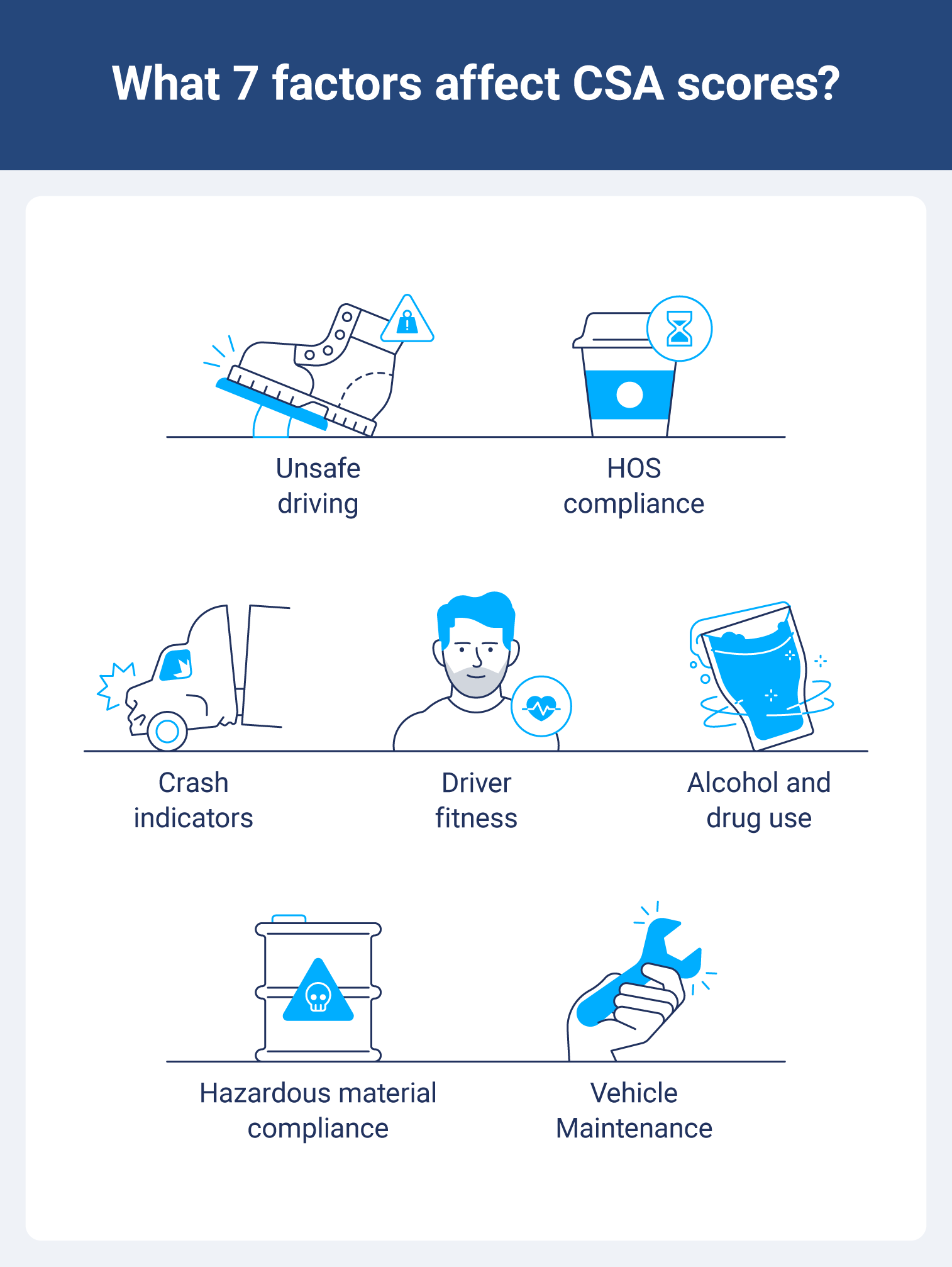
Unsafe driving
Unsafe driving includes speeding, reckless driving, improper lane change, not paying attention and failure to use a seat belt. The Driver Safety Scorecard Report from the Geotab Marketplace reveals which drivers practice unsafe driving practices. It tracks aggressive driving, seat belt usage and speeding.
This report is designed to maximize driver safety and identify your riskiest drivers. Use the real-world data to provide additional coaching and training tailored to specific risky driving behaviors, such as driver safety for speeders.
Hours of Service (HOS) compliance
The Federal Motor Carrier Safety Administration (FMCSA) has established Hours of Service (HOS) regulations. These regulations govern when commercial motor vehicle drivers can drive and when they need to take breaks, helping reduce collisions caused by driver fatigue.
The HOS Driver Violations Alert Report allows you to monitor compliance with HOS regulations. When a driver violates their HOS limits, an email is sent to the designated person(s). This provides full visibility into drivers who need additional training to guarantee HOS compliance.
Read more: California's Clean Truck Check [2025 Fleet Manager's Guide]
Driver fitness
Driver fitness refers to the qualities that make a person eligible to drive a commercial vehicle. These include possessing the proper driver’s license and being cleared by a medical professional.
Take these steps regularly to establish driver fitness:
- Require medical checkups
- Make sure drivers only drive vehicles within their training and certifications
- Keep related documentation for all employees (driving records, medical certificates, etc.)
- Check license status
If each driver is assigned a specific vehicle, follow these steps within Geotab’s platform:
- Engine & Maintenance > Reminder Rules > Add.
- Enter “License” as the description.
- Assign the driver’s license expiration date to their vehicle.
Be sure to set the rule to occur monthly and set no on mileage and engine hours.
Controlled substances/alcohol
This section of the CSA score focuses on whether drivers operate a commercial motor vehicle while possessing or using alcohol or drugs. Not only is this illegal, but it’s incredibly unsafe for everyone on the road. During a level 3 DOT inspection, drivers must provide documentation to verify they can legally and safely operate their vehicles.
Consider implementing dual-facing dash cameras to monitor your drivers and discourage them from driving under the influence. To view all available camera solutions integrating with MyGeotab, visit the Cameras and ADAS center on the Geotab Marketplace.
Vehicle maintenance
This part of the CSA score evaluation checks brakes, lights and other defects. If your company fails to make the required repairs, it can increase your CSA score.
Implement vehicle maintenance reminders focusing on brake system health, tire maintenance and light replacement. Get ahead by setting up a process to have reports emailed to your mechanic to identify developing problems. This will allow you to fix them early so they’re not discovered during an inspection or when a vehicle breaks down.
Choose Fleet Management Solutions from Geotab to help track and improve every CSA score factor.
Crash indicator
The crash indicator is an FMCSA measurement based on several factors:
- Crash rate and severity
- Size of fleet
- Distance traveled
This score isn’t public — you can only access information about your own fleet.
The Collision Reconstruction Add-In from the Geotab Marketplace allows you to view, analyze and interpret collision data from Geotab vehicle tracking devices. This tool allows fleet managers and administrators to view the position and the point of impact of any collision in their fleet. It also provides customized links to view the speed profile, RPM and accelerometer data during the collision.
Hazardous materials compliance
Hazardous materials (HM) compliance refers to whether a company adheres to the regulations around transporting HM. These violations include if the fleet doesn’t adhere to the following regulatory standards when transporting HM:
- Failure to mark, label or placard HM
- Not properly securing a package containing HM
- Unsafe loading or unloading practices
- Leaking HM
- Improper cargo tank specifications
How to improve CSA scores
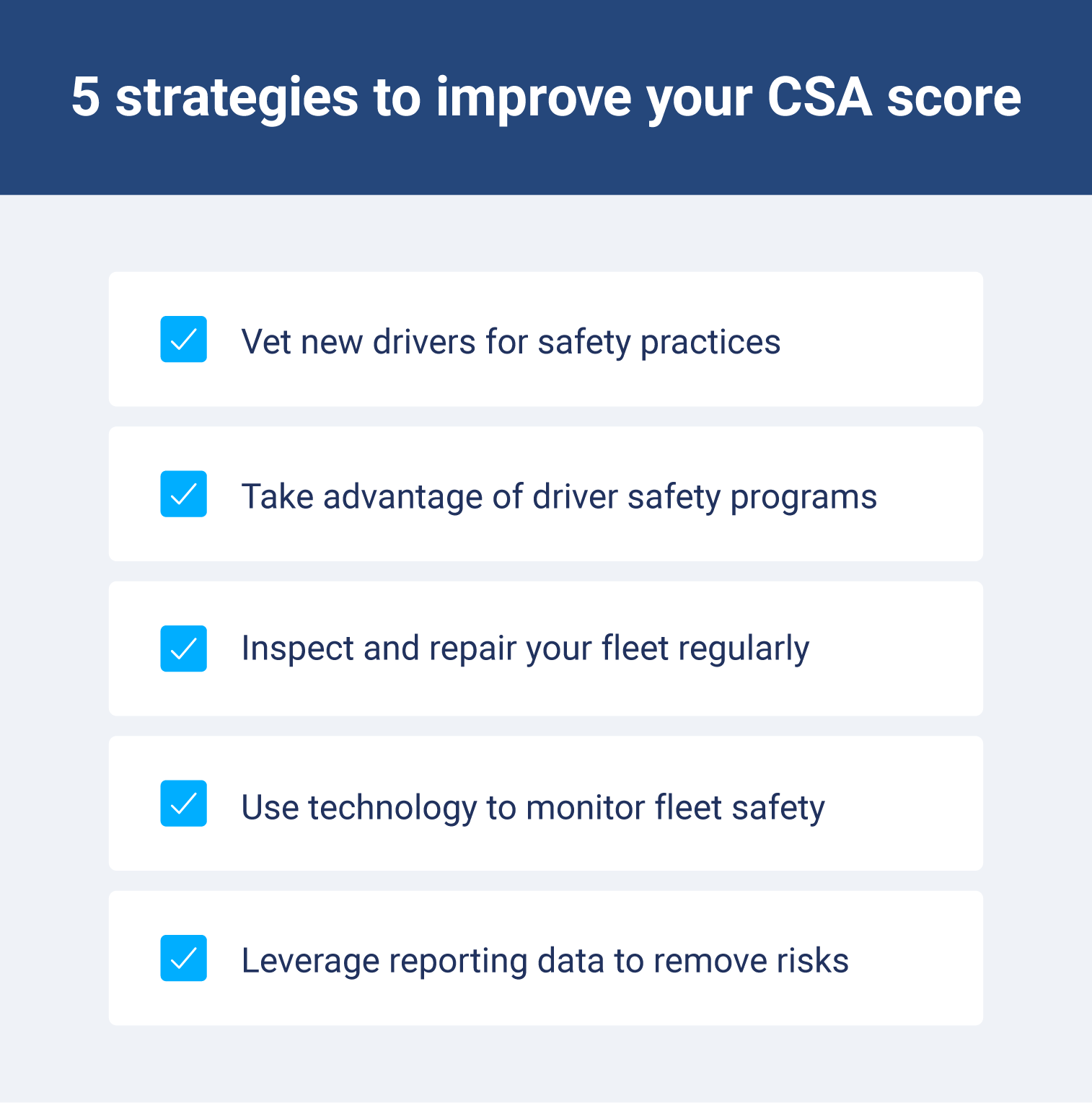
If your CSA score isn’t ideal, there are ways to improve it. Below, we’ll cover some high-impact changes you can make to lower your CSA score and improve safety. From improved training to tools that manage DOT compliance, these tips can help improve your fleet’s CSA score.
1. Carefully vet new drivers during the hiring process
To avoid any safety issues and decrease your CSA score, hiring drivers with a history of safe driving practices is important. Check each candidate’s driving record and follow up with reference to find any red flags.
2. Invest in driver safety programs
Even the most experienced drivers need a safety refresh every once in a while. Invest in fleet safety programs that help all drivers keep safety top of mind. These programs can help drivers learn vital skills like defensive driving or driving safely in bad weather.
3. Maintain your fleets
Frequent issues with your fleets can increase your CSA score, delay deliveries and endanger drivers. Schedule recurring fleet maintenance to stay on top of any mechanical problems and improve your company’s CSA score.
4. Use technology
Invest in your fleet and use the latest technology to monitor and improve safety practices that can improve your CSA score, such as:
- Video telematics: Use dashcam footage to give drivers real-time recommendations to improve their safety
- Xtract collision reconstruction: Xtract captures real-time data, such as speed limits, driver speed and weather conditions, for accurate collision reporting
5. Leverage reporting data
Reporting data is an important tool for providing contextual fleet safety, which can help lower your carrier’s CSA score.
With this data, you can more accurately confirm whether a driver is at fault after a crash, if they’re practicing safe driving, or even if a particular route isn’t well-maintained and should be avoided. This allows you to take action sooner and improve carrier safety.
Where to check your CSA score
You can find your CSA score on the FMCSA website. You’ll need to know your company’s United States Department of Transportation (USDOT) login and PIN to search for your CSA score on the Safety Measurement System (SMS) index. However, you won’t find CSA scores for drivers because the FMCSA evaluates companies and not individuals.
With this in mind, how can you pinpoint where drivers need more support? Driver Safety Reports from Geotab track activities like speeding, seatbelt use and harsh braking. This can help deter drivers from unsafe practices, identify where fleets need more safety support and help lower the carrier’s CSA score.
Lower CSA scores with real data from Geotab
You can’t overstate a good CSA score’s impact on a trucking company. From attracting more experienced employees to keeping costs down, driver safety drives success from multiple angles.
You’re not alone in your efforts to improve your fleet’s CSA score. Fleet Management Solutions from Geotab use comprehensive risk management technology to improve safety, lower operating risks and protect your fleet from risks on the road.
Subscribe to get industry tips and insights
Frequently Asked Questions
CSA score points are penalties given to drivers and companies for unsafe practices like HOS violations, failed inspections or speeding. Depending on the severity of the violation, you can receive up to ten points per violation.
Lower CSA scores are better than higher scores. A CSA score under 50 is acceptable, but your company should aim to get as close to 0 as possible.
A CSA score of 50 or more is generally very serious. When any individual category hits 50, your company should start working to remedy and improve your score. Once a score reaches 65, FMCSA will open an investigation, so early intervention is key.
CSA scores are visible on the FMCSA website. Use the Safety Measurement System (SMS) index to log in with your carrier’s United States Department of Transportation (USDOT) login and PIN.
A better carrier safety rating can lower insurance rates, attract new business and reduce the frequency of safety audits. To lower your CSA score, you’ll need to invest in safe driving for your fleet and make sure your drivers follow best practices consistently. This includes having regular inspections and vehicle repairs, hiring safe drivers and using technology to improve compliance with FMCSA standards.
No, drivers don’t have CSA scores. The FMCSA evaluates companies, not individual drivers.

Frankie Van Puyenbroeck is a Digital Automation Specialist at Geotab.
Table of Contents
Subscribe to get industry tips and insights
Related posts
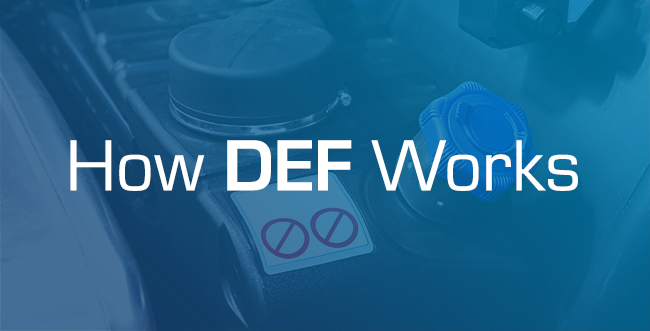
What is DEF? How diesel exhaust fluid works and why it's essential for fleets
July 16, 2025
5 minute read
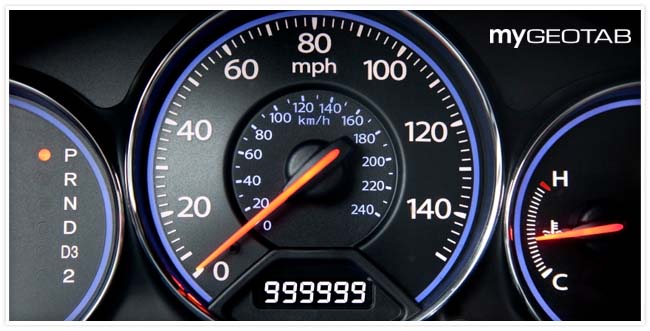
Odometer reading: How to check + optimize for smarter fleet management
July 15, 2025
5 minute read

.jpg)
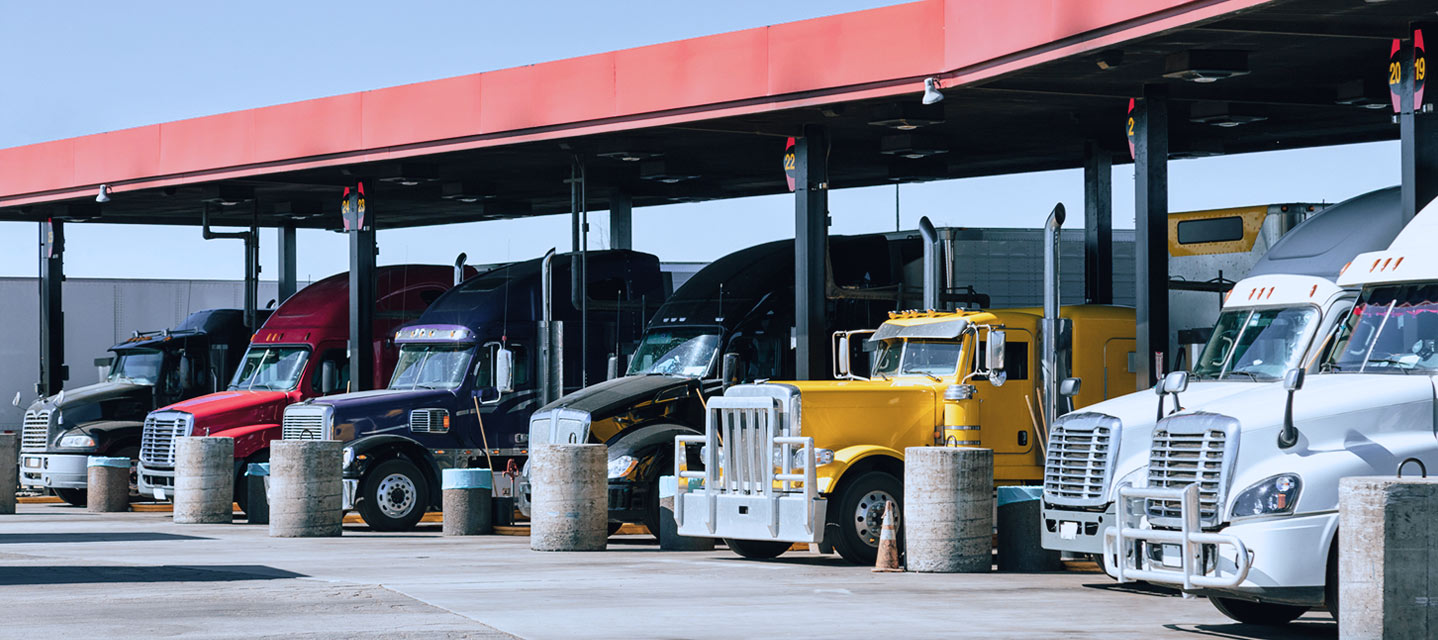
9 strategies to increase fleet fuel efficiency and lower fuel costs
July 8, 2025
4 minute read

Creating a fleet safety culture that’s built to last: Lessons from Missouri DOT and NYC
July 7, 2025
8 minute read